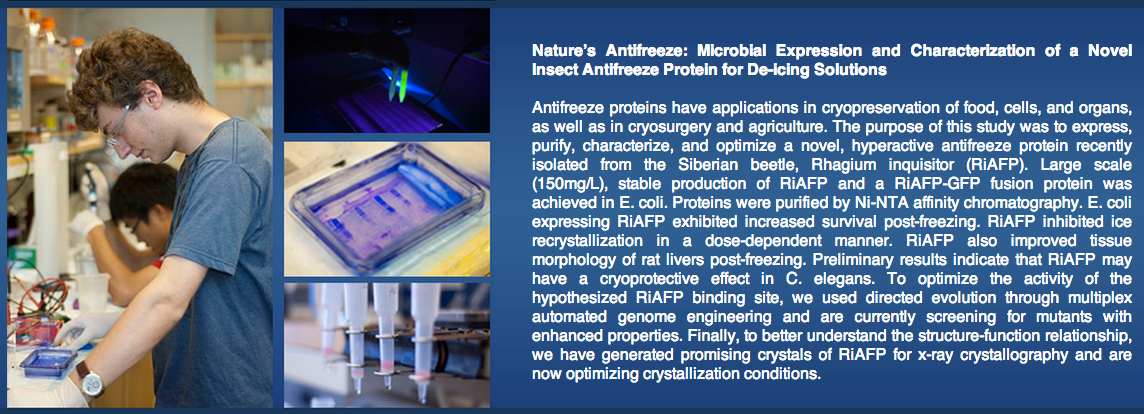Tracks/Energy
From 2014.igem.org
iGEM 2014 Energy Track
Until 2014, Food and Energy were included as a track in iGEM. This year, we are separating these two concepts into the Food and Nutrition Track and the Energy Track. We want to highlight that while there is a lot of crossover in these two track ideas, they seek to resolve fundamentally different problems.
A major economic driver for most countries is energy availability and use. While natural gas, oil and coal reserves are still likely to last humanity for many hundreds of years, their distribution across the planet is not equal. The ability for a nation to produce it's own transportation fuel, irrespective available natural resources will be a huge source of economic growth in the 21st century. Synthetic biology may have the answer to some, if not all of these pressing global issues.
You will find images and abstracts of teams who worked on energy problems from 2011 to 2013 in the page below. Also, follow the links below to see projects from all the Energy track teams.
Recent Food and Energy projects to win best in track
Winning Energy projects in 2013 Overgrad: Ecolectricity - currently available
Bielefeld
Project abstract:There is a growing interest in the use of ecologically friendly alternative energy sources because of the depletion of fossil fuels and an increasing environmental pollution. Therefore, we are developing a Microbial Fuel Cell (MFC). The goal of this project is to generate electricity with a modified Escherichia coli in a self-constructed fuel cell. Besides the technical optimization of the fuel cell, we investigate different genetic approaches like integrating porines and cytochromes as well as endogenous mediators. Using heterologous expression of pore-forming transmembrane proteins, we are able to enhance the extracellular electron transfer, leading to higher membrane permeability. Direct electron transfer can be achieved by integrating cytochromes into the cellular membrane, whereas a production of endogenous mediators enhances the electron transport to the electrode. With different aspects for technical and genetic optimization we enable Ecolectricity, the use of E. coli for direct energy production.
Winning Food and Energy project 2011: (Tie) Washington and Yale
Washington
The University of Washington 2011 iGEM team also won the Grand Prize BioBrick trophy at the World Championship Jamboree.
Project abstract: Synthetic biology holds great promise regarding the production of important compounds, and the degradation of harmful ones. This summer, we harnessed the power of synthetic biology to meet the world's needs for fuel and medicine. Make It: We constructed a strain of Escherichia coli that produces a variety of alkanes, the main constituents of diesel fuel, by introducing a pair of genes recently shown convert fatty acid synthesis intermediates into alkanes. Break It: We identified a protease with gluten-degradation potential, and then reengineered it to have greatly increased gluten-degrading activity, allowing for the breakdown of gluten in the digestive track when taken in pill form. Finally, to enable next-generation cloning of standard biological parts, BioBrick vectors optimized for Gibson assembly were constructed and used to construct the Magnetosome Toolkit: genes for biofabrication of magnetic particles.
Yale
Project abstract: Antifreeze proteins have applications in cryopreservation of food, cells, and organs, as well as in cryosurgery and agriculture. The purpose of this study was to express, purify, and characterize a novel, hyperactive antifreeze protein recently isolated from the Siberian beetle, Rhagium inquisitor (RiAFP). Large scale (150mg/L), stable production of RiAFP and a RiAFP-GFP fusion protein was achieved in E. coli. Proteins were purified using Ni-NTA affinity chromatography. E. coli expressing RiAFP exhibited increased survival post-freezing. RiAFP inhibited ice recrystallization in both splat and capillary assay. To optimize the activity of the hypothesized RiAFP ice binding site, we are using directed evolution through multiplex automated genome engineering (MAGE). Finally, we are further optimizinge our crystallization conditions for RiAFP to better understand the structure-function relationship, as well as conducting post-freezing survival assays in C. elegans.
 "
"